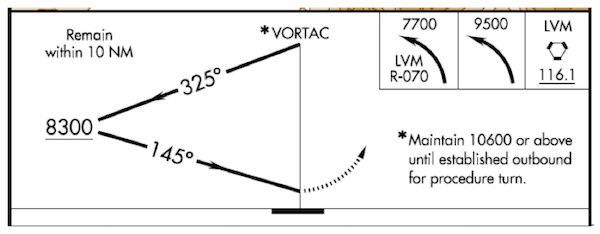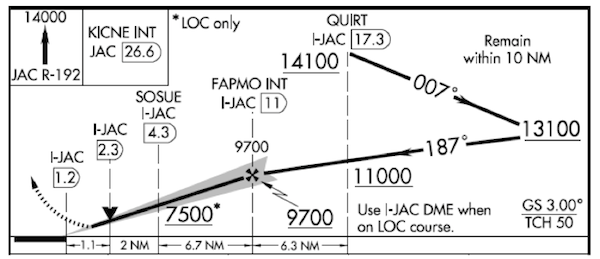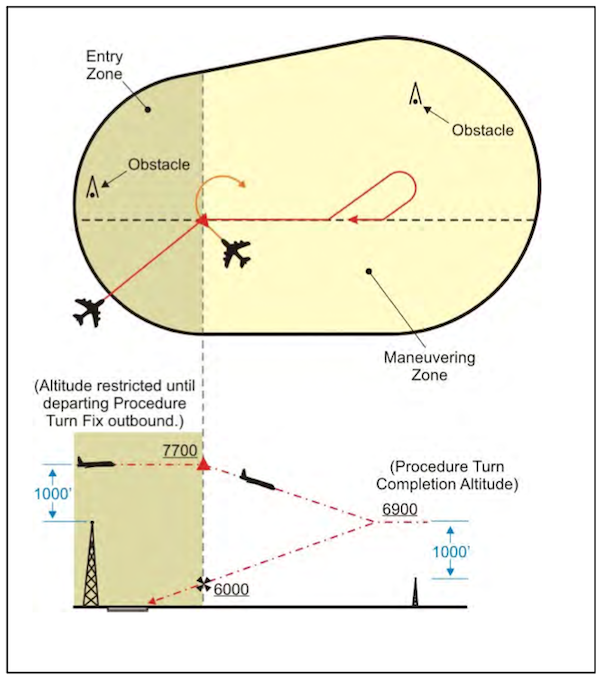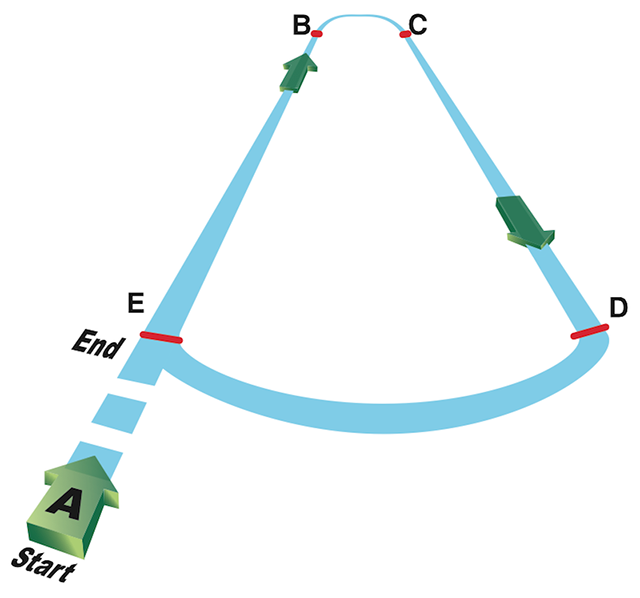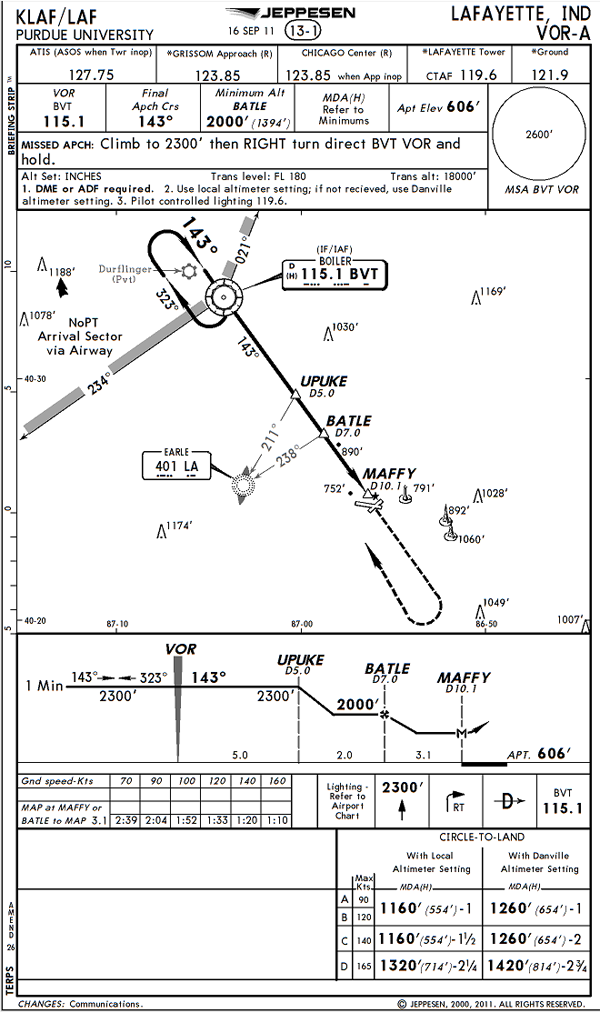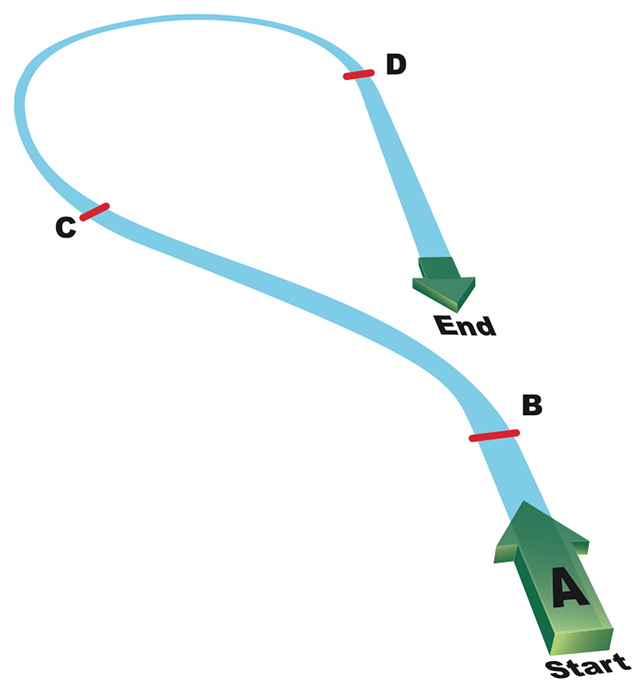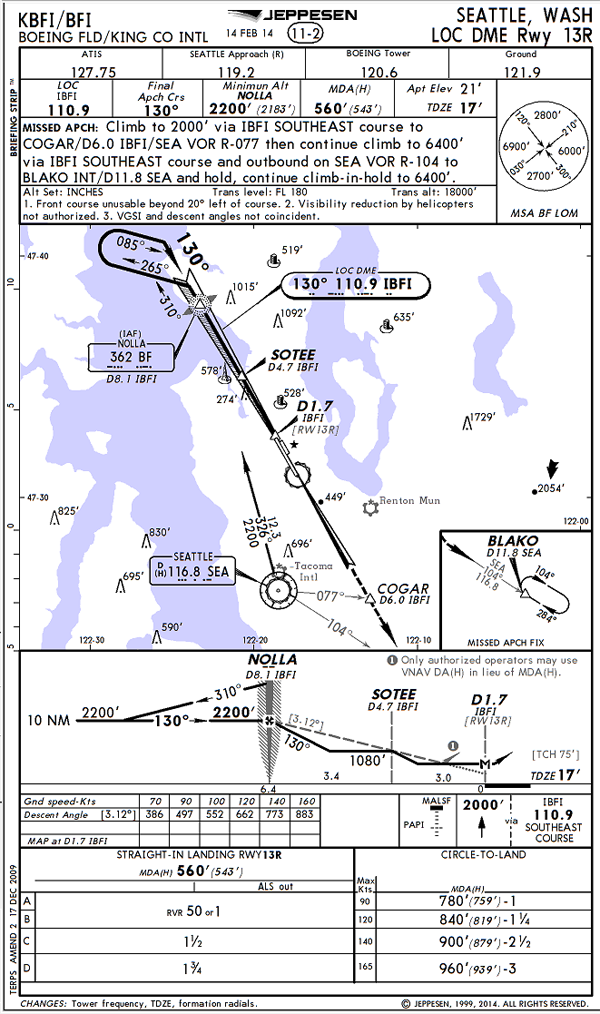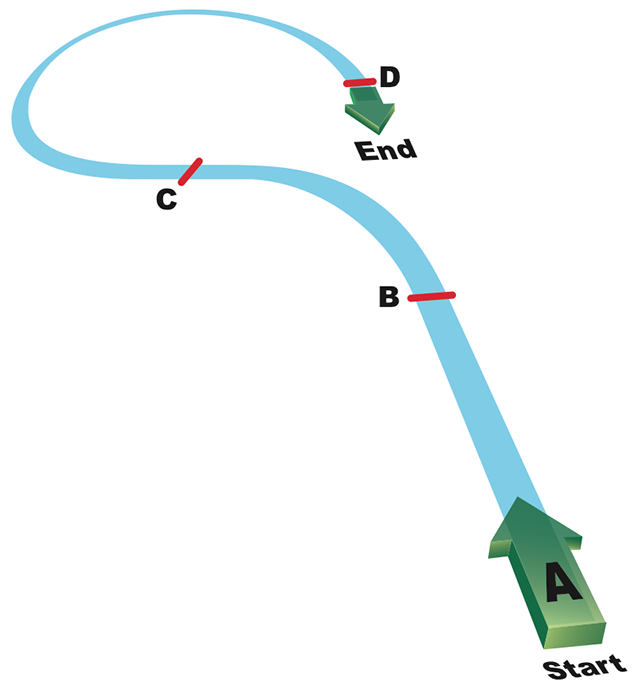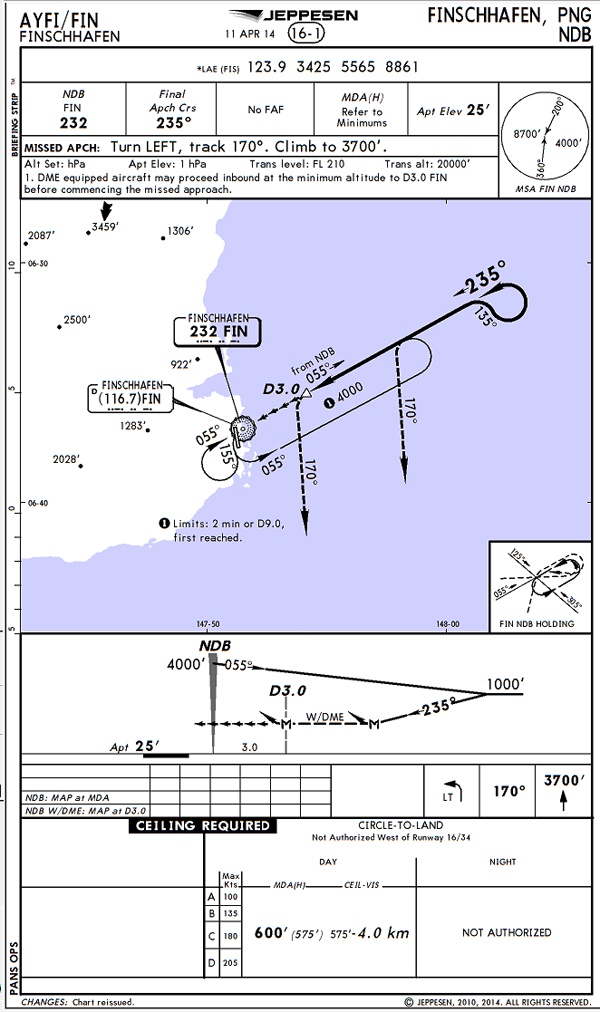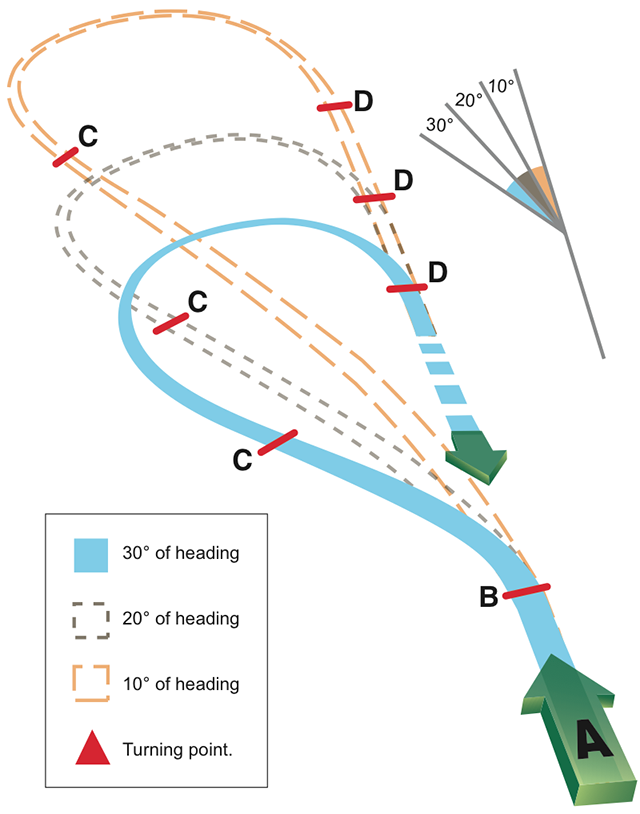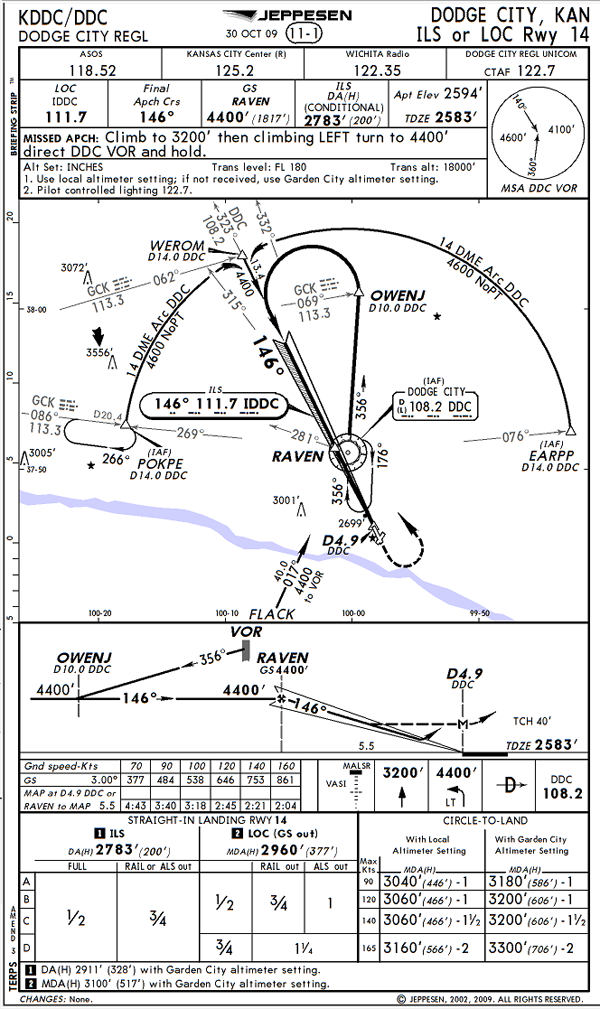In 1979 I started flying instrument procedures in the Cessna T-37B and using an instrument procedures manual that was all of 139 pages of which one was devoted to procedure turns and another to holding-in-lieu of procedure turns.
— James Albright

Updated:
2020-01-19
It really was that easy and we were told these could get us through a low altitude instrument approach anywhere in the world. As it turns out, we in the Air Force found out about five years later, that is wrong. You can get away with these two techniques in the United States and in a few of the places that have adopted TERPS but if you want to do what the International Civil Aviation Organization (ICAO) calls a course reversal, you will have to learn a new set of tricks. More about this: Course Reversals.
1 — Procedure turn and hold-in-lieu of procedure turn
2 — Racetrack (or hold-in-lieu of procedure turn)

1
Procedure turn and hold-in-lieu of procedure turn
A procedure turn is the maneuver prescribed when it is necessary to reverse direction to establish the aircraft inbound on an intermediate or final approach course. The procedure turn or hold-in-lieu-of-PT is a required maneuver when it is depicted on the approach chart, unless cleared by ATC for a straight-in approach. Additionally, the procedure turn or hold-in-lieu-of-PT is not permitted when the symbol “No PT” is depicted on the initial segment being used, when a RADAR VECTOR to the final approach course is provided, or when conducting a timed approach from a holding fix. The altitude prescribed for the procedure turn is a minimum altitude until the aircraft is established on the inbound course. The maneuver must be completed within the distance specified in the profile view. For a hold-in-lieu-of-PT, the holding pattern direction must be flown as depicted and the specified leg length/timing must not be exceeded.
NOTE-The pilot may elect to use the procedure turn or hold-in-lieu-of-PT when it is not required by the procedure, but must first receive an amended clearance from ATC. If the pilot is uncertain whether the ATC clearance intends for a procedure turn to be conducted or to allow for a straight-in approach, the pilot must immediately request clarification from ATC.
Source: Aeronautical Information Manual, §5-4-9.a
The "minimum altitude until the aircraft is established on the inbound course" begs the question, when are you established? Many pilots use "CDI off the wall" as their trigger. That could be four miles or more off course, depending on the procedure and the distance from the navigation aid. The real answer is in TERPS and varies with procedure type, altitude, and a few other factors. The tolerance can be a mile or less. Your CDI may or may not reflect linear distance. The safe bet here: on course is on course, center the needle.
Execution
On U.S. Government charts, a barbed arrow indicates the maneuvering side of the outbound course on which the procedure turn is made. Headings are provided for course reversal using the 45 degree type procedure turn. However, the point at which the turn may be commenced and the type and rate of turn is left to the discretion of the pilot (limited by the charted remain within xx NM distance). Some of the options are the 45 degree procedure turn, the racetrack pattern, the teardrop procedure turn, or the 80 degree ↔ 260 degree course reversal. Racetrack entries should be conducted on the maneuvering side where the majority of protected airspace resides. If an entry places the pilot on the non-maneuvering side of the PT, correction to intercept the outbound course ensures remaining within protected airspace. Some procedure turns are specified by procedural track. These turns must be flown exactly as depicted.
Source: Aeronautical Information Manual, §5-4-9.a.1.
Descent to the procedure turn (PT) completion altitude from the PT fix altitude (when one has been published or assigned by ATC) must not begin until crossing over the PT fix or abeam and proceeding outbound. Some procedures contain a note in the chart profile view that says “Maintain (altitude) or above until established outbound for procedure turn.”
Source: Aeronautical Information Manual, §5-4-9.a.2
Newer procedures will simply depict an “at or above” altitude at the PT fix without a chart note.
Both are there to ensure required obstacle clearance is provided in the procedure turn entry zone.
Absence of a chart note or specified minimum altitude adjacent to the PT fix is an indication that descent to the procedure turn altitude can commence immediately upon crossing over the PT fix, regardless of the direction of flight. This is because the minimum altitudes in the PT entry zone and the PT maneuvering zone are the same.
Maximum Speed
When the approach procedure involves a procedure turn, a maximum speed of not greater than 200 knots (IAS) should be observed from first over heading the course reversal IAF through the procedure turn maneuver to ensure containment within the obstruction clearance area.
Source: Aeronautical Information Manual, §5-4-9.a.3.
Turns
Pilots should begin the outbound turn immediately after passing the procedure turn fix. The procedure turn maneuver must be executed within the distance specified in the profile view. The normal procedure turn distance is 10 miles.
Source: Aeronautical Information Manual, §5-4-9.a.3
2
Racetrack (or hold-in-lieu of procedure turn)
A holding pattern in lieu of procedure turn may be specified for course reversal in some procedures. In such cases, the holding pattern is established over an intermediate fix or a final approach fix. The holding pattern distance or time specified in the profile view must be observed. For a hold-in-lieu-of-PT, the holding pattern direction must be flown as depicted and the specified leg length/timing must not be exceeded. Maximum holding airspeed limitations as set forth for all holding patterns apply. The holding pattern maneuver is completed when the aircraft is established on the inbound course after executing the appropriate entry. If cleared for the approach prior to returning to the holding fix, and the aircraft is at the prescribed altitude, additional circuits of the holding pattern are not necessary nor expected by ATC. If pilots elect to make additional circuits to lose excessive altitude or to become better established on course, it is their responsibility to so advise ATC upon receipt of their approach clearance.
Source: Aeronautical Information Manual, §5-4-9.a.5.
What AIM calls a holding pattern in lieu of procedure turn is now called a racetrack procedure, as given in most ICAO sources and to a recent update in the FAA Instrument Flying Handbook. . .
- Time 3 minutes straight-and-level flight from A to B. During this interval, reduce airspeed to the holding speed appropriate for the aircraft.
- Start a 180° standard rate turn to the right at B. Rolling out at C on the reciprocal of the heading originally used at A.
- Time a 1 minute straight-and-level flight from C to D.
- Start a 180° standard rate turn to the right at D, rolling out on the original heading.
Source: FAA-H-8083-15B Instrument Flying Handbook, page 7-30
You would be wise to apply a drift correction here to the outbound leg. If the wind is very strong blowing you toward the inbound course, you may want to double the drift to improve your odds of rolling out on course. Some pilots do this also for a wind blowing away from the course. This might work, but you need to be mindful of exceeding protected airspace.
You will not need to time if a DME or different time interval may be specified on the instrument approach plate.
You should attempt to roll out on course and if not on course, apply a correction back to course. Under some rules you are allowed to head directly to the holding point the first time around, but this is not always true. I recommend you correct to course.
Example
The VOR-A into Purdue University airport includes a race track procedure with a stated 1 minute time.
- Entry is made using standard holding pattern procedures with only the AIM caveat given earlier: "Racetrack entries should be conducted on the maneuvering side where the majority of protected airspace resides. If an entry places the pilot on the non-maneuvering side of the PT, correction to intercept the outbound course ensures remaining within protected airspace."
- Using these entry procedures, pilots need only be mindful of the aircraft's offset from the inbound course. You need to have enough offset to roll out inbound on course. This can be critical on other race track procedures but the designers of this approach included a 5.0 NM leg before permitting the next descent.
3
Standard 45° procedure turn (or 45°/180° pattern)
- Start timing at point A (usually identified on approach procedure by a fix). For example, fly outbound on a heading of 360° for a given time (2 minutes, in this example).
- After flying outbound for 2 minutes (point B), turn left 45° to a heading of 315° using a standard rate turn. After roll-out and stabilizing, fly this new heading of 315° for 40 seconds and the aircraft will be at the approximate position of C.
- At point C, turn 225° right (using a standard rate turn) which will provide a heading of 180°. The timing is such that in a no wind environment, the pilot will be aligned with the final approach course of 180° at D. Wind conditions, however must be considered during the execution of the procedure turn. Compensating for wind may result in changes in outbound time, procedure turn heading and/or time and minor changes in the inbound turn.
Source: FAA-H-8083-15B Instrument Flying Handbook, page 7-30
The length of the outbound leg can be specified by DME, a fix, or timing shown on the approach plate itself.
Using 40 seconds after roll is certainly a technique, but it doesn't look like a good technique. I recommend using ICAO procedure here which calls for 1 minute from the start of the turn for Category A and B aircraft, 1 minute 15 seconds for Category C, D, and E aircraft.
If you decide you are going to need to adjust outbound time or heading to compensate for wind, consider obstacles and let ATC know what you are doing.
Example
The LOC DME Rwy 13R into Boeing Field includes a standard 45° procedure turn without any DME restrictions other than the aircraft must remain within 10 NM of the final approach fix, NOLLA. It is up to you how far to fly before starting the 45° leg and, depending on if you want to comply with ICAO guidance or not, how long to fly that leg before turning. So a lot is left on your shoulders. Here is my method on how to make these decisions:
- In the G450 my outbound flap setting will be 10° and I will be at 180 KCAS, which is 3 nm/minute. It would take me 3 minutes 20 seconds to fly the 10 NM limit without any turns, so my timing must not exceed that.
- The 45° leg is limited to 1 minute 15 seconds for a Category C/D/E aircraft if you fly ICAO time limits, leaving you 2 minutes 5 seconds.
- I can then subtract the time spent in the 180° turn, much of which is pointed back to the runway, and have a conservative pad. The time spent in half of a turn made at the standard rate takes 1 minute, leaving us with 1 minute 5 seconds.
- Based on these calculations, I believe I can proceed outbound for 1 minute, turn and start timing, roll out on a 265° heading, after 1 minute turn right to a heading of 085°, and intercept the inbound course. Because my time limit didn't include the mitigating factor of the time spent off heading and the turn inbound, I should be well within the 10 NM limit. (I've been using this technique for decades and it has always worked.)
4
80°/260° procedure turn
- Start timing at point A (usually identified on approach procedures by a fix). For example, fly outbound on a heading of 360° for 2 minutes.
- At B enter a left standard rate turn of 80° to a heading of 280°.
- At the completion of the 80° turn to 280° (Point C), immediately turn right 260°, rolling-out on a heading of 180° (Point D) and also the reciprocal of the entry heading.
Source: FAA-H-8083-15B Instrument Flying Handbook, page 7-31
Example
I've never seen a published 80°/260° Procedure Turn in the United States and those I've seen internationally are a disappearing breed. There are a few left in Papua New Guinea and I've seen one in Egypt. But most places that have had them long ago changed to racetrack, base turn, or standard procedure turns. The 80°260° gives the pilot very little room to adjust for winds. If given a choice, any course reversal should be preferred to the 80°/260°.
More about this: Course Reversals.
5
Teardrop procedure
A teardrop procedure or penetration turn may be specified in some procedures for a required course reversal. The teardrop procedure consists of departure from an initial approach fix on an outbound course followed by a turn toward and intercepting the inbound course at or prior to the intermediate fix or point. Its purpose is to permit an aircraft to reverse direction and lose considerable altitude within reasonably limited airspace. Where no fix is available to mark the beginning of the intermediate segment, it must be assumed to commence at a point 10 miles prior to the final approach fix. When the facility is located on the airport, an aircraft is considered to be on final approach upon completion of the penetration turn. However, the final approach segment begins on the final approach course 10 miles from the facility.
Source: Aeronautical Information Manual, §5-4-9.a.4.
There are three typical teardrop patterns. A 30°, 20°, and a 10° teardrop pattern. The below steps indicate actions for all three starting on a heading of 360°.
- At point B (after stabilizing on the outbound course) turn left:
- 30° to a heading of 330° and time for 1 minute
- 20° to a heading of 340° and time for 2 minutes
- 10° to a heading of 350° and time for 3 minutes
- After the appropriate time above (Point C), make a standard rate turn to the right for:
- 30° teardrop &mash; 210° to the final course heading of 180° (Point D)
- 20° teardrop &mash; 200° to the final course heading of 180° (Point D)
- 10° teardrop &mash; 190° to the final course heading of 180° (Point D)
Source: FAA-H-8083-15B Instrument Flying Handbook, page 7-31
Example
The ILS or LOC Rwy 14 into Dodge City Regional includes a 30° teardrop procedure turn with a DME turn point. The approach is straight forward. I would be tempted to compute a bank angle to make the turn and roll out precisely on course, but would not do this because I want to get the aircraft heading back to the runway as quickly as possible, just to get the airplane on the ground expeditiously. Given that, I would use a standard rate turn inbound followed by normal course intercept procedures.
References
(Source material)
Air Force Manual (AFM) 51-37, Instrument Flying, 1 December 1976
Aeronautical Information Manual
FAA-H-8083-15B, Instrument Flying Handbook, U.S. Department of Transportation, Flight Standards Service, 2012
ICAO Doc 8168 - Aircraft Operations - Vol I - Flight Procedures, Procedures for Air Navigation Services, International Civil Aviation Organization, 2006
Jeppesen Airway Manual
United States Standard for Terminal Instrument Procedures (TERPS), Federal Aviation Administration 8260.3B CHG 25, 03/09/2012
